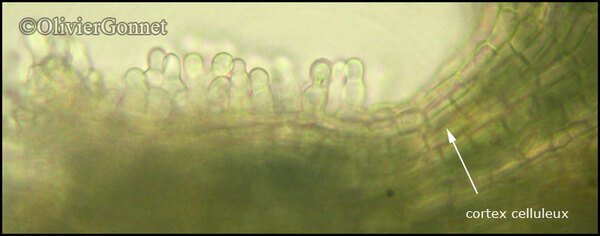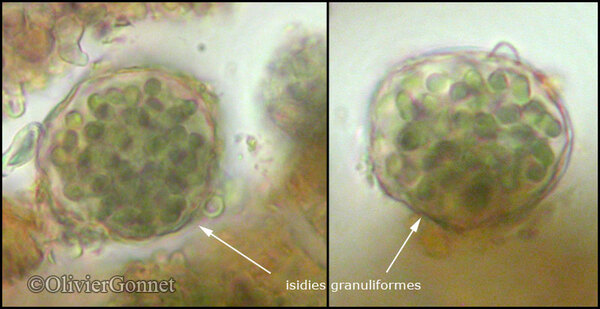Scytinium microphylloides (Nyl.) ined.
. Basionym: Leptogium microphylloides Nyl. - Mém. Soc. Imp. Sci. Nat. Cherbourg, 5: 338, 1858
Synonyms:
Distribution: C - Marc (Nimis & Tretiach 1999), Laz (Ravera 2008, Ravera & Genovesi 2008). S - Camp (Ravera & Brunialti 2013), Pugl (Nimis & Tretiach 1999), Bas (Nimis & Tretiach 1999).
Description: Thallus small-foliose to dwarf-fruticose, lead-grey, olive-brown to brown-black, subgelatinous when wet, richly branched, the lobes sinuous, dense, ascending, bearing numerous, marginal and/or laminal, 0.1-0.2 mm wide, papilliform to granulose, isidia. Upper and lower cortex consisting of irregularly isodiametric cells. Apothecia very rare, lecanorine, 0.2-0.4 mm across. Asci 8-spored, narrowly clavate, the apex strongly thickened, the apical dome K/I+ pale blue, with a downwardly projecting K/I+ deep blue tubular structure. Ascosporesmuriform, ellipsoid, 20-221 x 10-12 µm. Photobiont cyanobacterial (Nostoc, the cells in clusters or in short chains). Spot tests: all negative. Chemistry: without lichen substances.Note: here I place mainoy epiphytic, richly branched specimens resembling S. teretiusculum, with marginal and sometimes also laminal isidia, which were often called Leptogium microphylloides by European authors (see e.g. Christensen 2014). They were regarded as a mere -growth form of S. teretiusculum by Jørgensen (1994a) and Jørgensen & Tønsberg (1999), but according to Nimis & Tretiach (1999) and Christensen (2014) they deserve to be treated an independent species. The species was described from France and was not treated by Otálora & al. (2014); it is however not certain whether the samples called Leptogium microphylloides in the European literature really correspond with the type of Leptogium microphylloides Nyl.
Growth form: Squamulose
Substrata: bark
Photobiont: cyanobacteria, filamentous (e.g. Nostoc, Scytonema)
Reproductive strategy: mainly sexual
Poorly known taxon in need of further study
Commonnes-rarity: (info)
Alpine belt: absent
Subalpine belt: absent
Oromediterranean belt: absent
Montane belt: absent
Submediterranean belt: very rare
Padanian area: absent
Humid submediterranean belt: very rare
Humid mediterranean belt: absent
Dry mediterranean belt: very rare
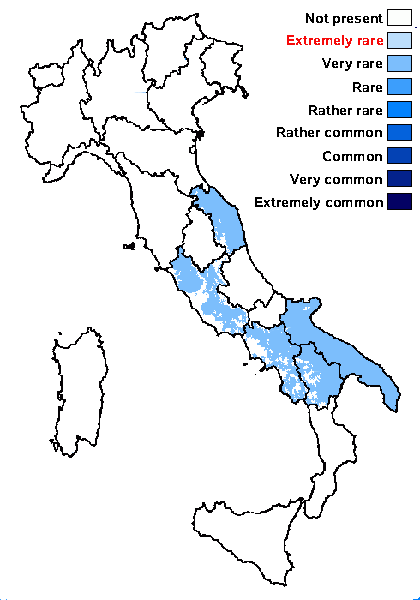
Predictive model
Herbarium samples
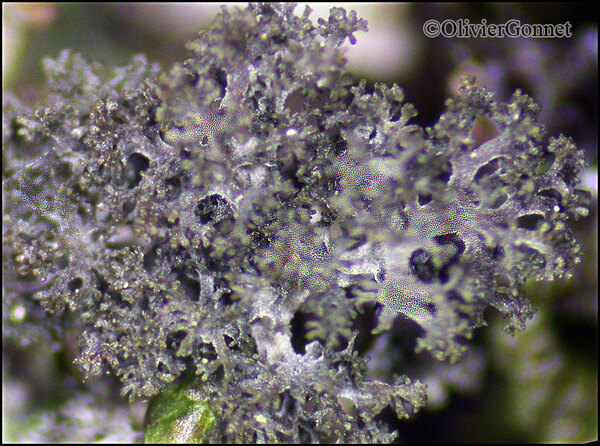
Courtesy Danièle et Olivier Gonnet - Source: https://www.afl-lichenologie.fr/Photos_AFL/Photos_AFL_L/Texte_L_5/Leptogium_microphylloides.htm
France, D957 Miluccia Bocca di Feliciolu, alt. 800m - Corse - (20) - sur Quercus ilex et mousses
27/4/2011
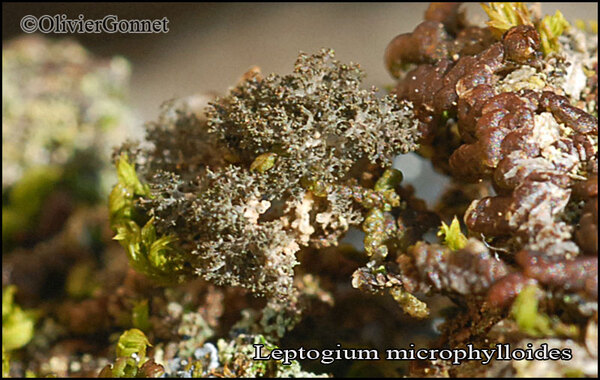
Courtesy Danièle et Olivier Gonnet - Source: https://www.afl-lichenologie.fr/Photos_AFL/Photos_AFL_L/Texte_L_5/Leptogium_microphylloides.htm
France, D957 Miluccia Bocca di Feliciolu, alt. 800m - Corse - (20) - sur Quercus ilex et mousses
27/4/2011
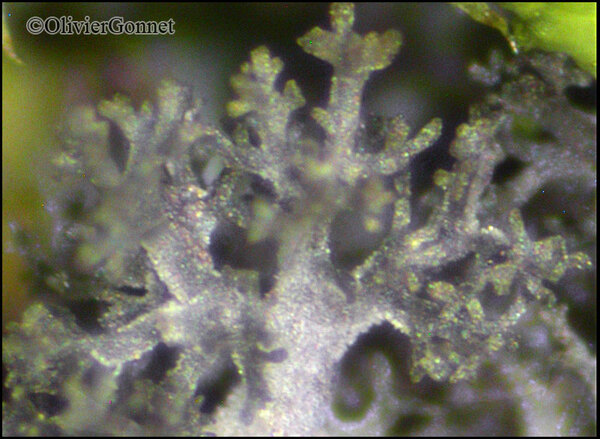
Courtesy Danièle et Olivier Gonnet - Source: https://www.afl-lichenologie.fr/Photos_AFL/Photos_AFL_L/Texte_L_5/Leptogium_microphylloides.htm
France, D957 Miluccia Bocca di Feliciolu, alt. 800m - Corse - (20) - sur Quercus ilex et mousses
27/4/2011
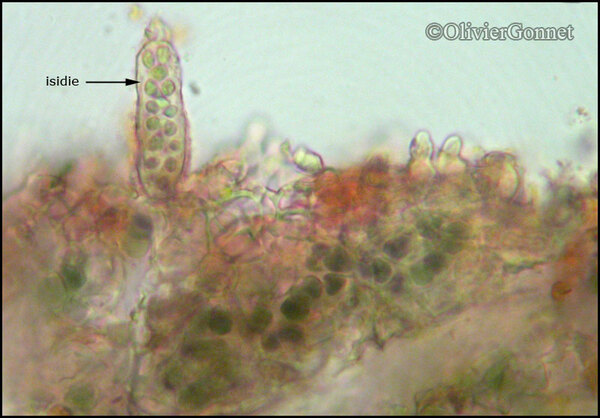
Courtesy Danièle et Olivier Gonnet - Source: https://www.afl-lichenologie.fr/Photos_AFL/Photos_AFL_L/Texte_L_5/Leptogium_microphylloides.htm
France, D957 Miluccia Bocca di Feliciolu, alt. 800m - Corse - (20) - sur Quercus ilex et mousses
27/4/2011
Growth form: Squamulose
Substrata: bark
Photobiont: cyanobacteria, filamentous (e.g. Nostoc, Scytonema)
Reproductive strategy: mainly sexual
Poorly known taxon in need of further study
Commonnes-rarity: (info)
Alpine belt: absent
Subalpine belt: absent
Oromediterranean belt: absent
Montane belt: absent
Submediterranean belt: very rare
Padanian area: absent
Humid submediterranean belt: very rare
Humid mediterranean belt: absent
Dry mediterranean belt: very rare

Predictive model
| Herbarium samples |

Courtesy Danièle et Olivier Gonnet - Source: https://www.afl-lichenologie.fr/Photos_AFL/Photos_AFL_L/Texte_L_5/Leptogium_microphylloides.htm
France, D957 Miluccia Bocca di Feliciolu, alt. 800m - Corse - (20) - sur Quercus ilex et mousses
27/4/2011

Courtesy Danièle et Olivier Gonnet - Source: https://www.afl-lichenologie.fr/Photos_AFL/Photos_AFL_L/Texte_L_5/Leptogium_microphylloides.htm
France, D957 Miluccia Bocca di Feliciolu, alt. 800m - Corse - (20) - sur Quercus ilex et mousses
27/4/2011

Courtesy Danièle et Olivier Gonnet - Source: https://www.afl-lichenologie.fr/Photos_AFL/Photos_AFL_L/Texte_L_5/Leptogium_microphylloides.htm
France, D957 Miluccia Bocca di Feliciolu, alt. 800m - Corse - (20) - sur Quercus ilex et mousses
27/4/2011

